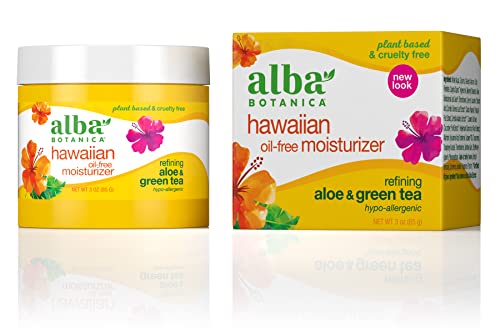
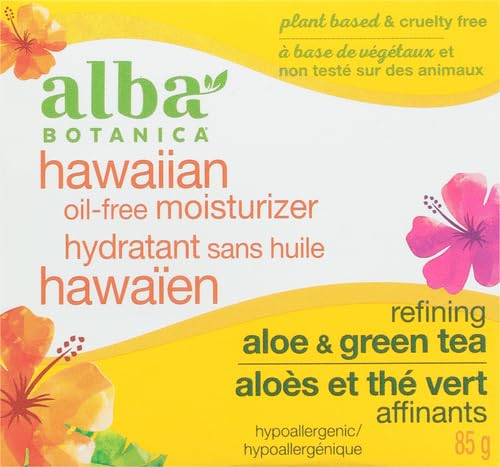
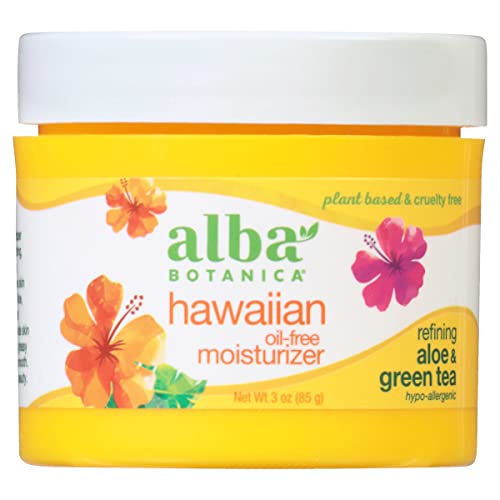
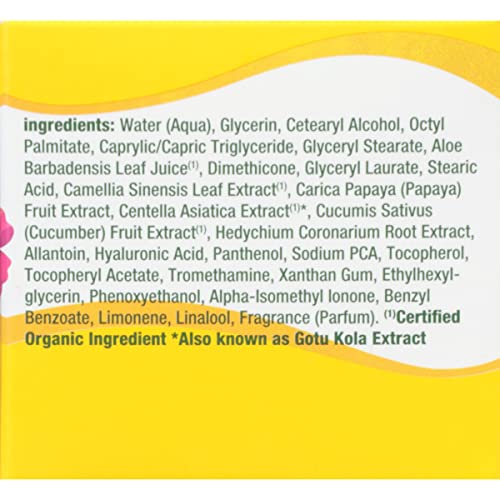
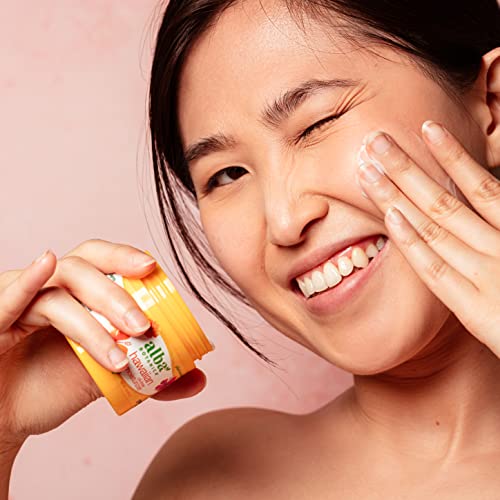
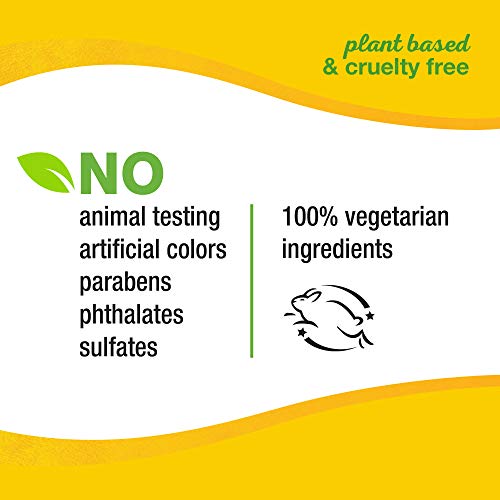
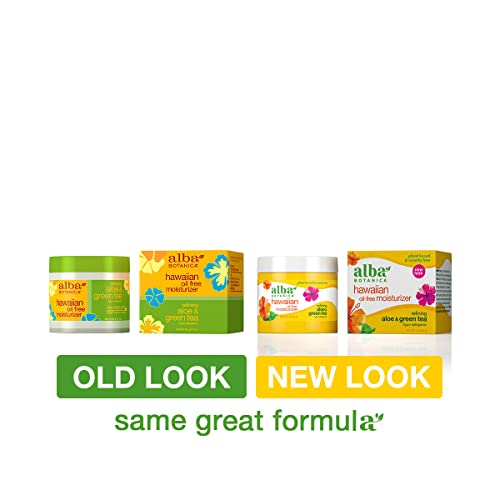
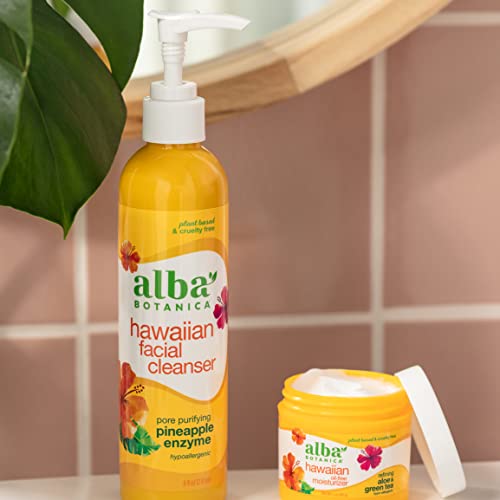
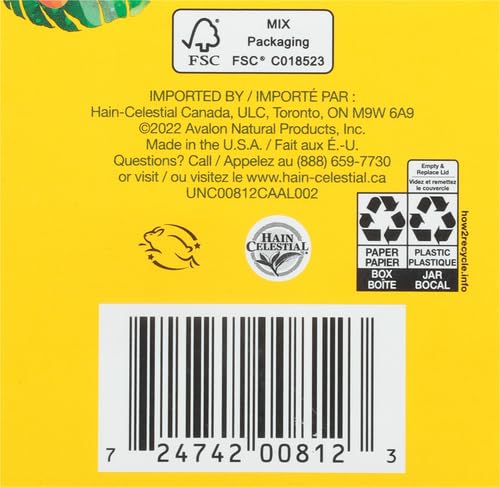
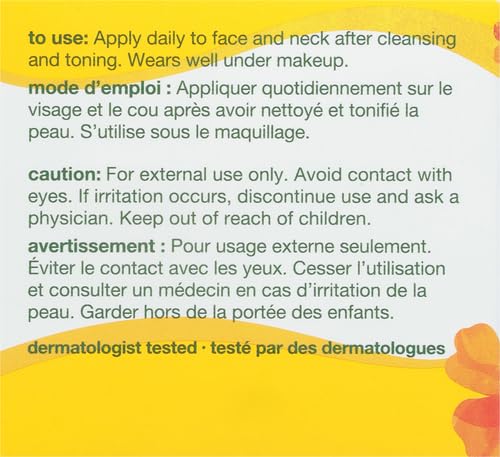
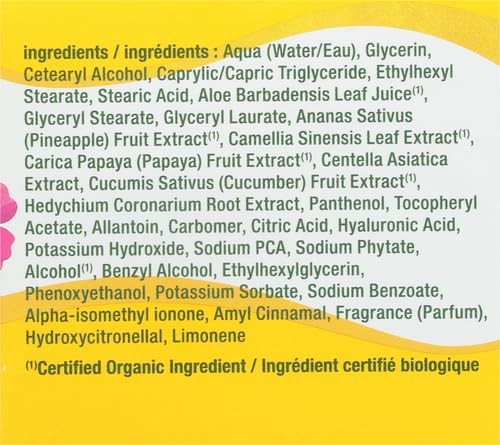

Alba Botanica Moisturizer - Hydrates & Refines Pores, Vegetarian Formula - 3oz Aloe & Green Tea


Benzyl Alcohol
High RiskBenzyl alcohol is a naturally occurring and synthetic aromatic alcohol commonly used as a solvent, preservative, and fragrance ingredient in various products. It is found in both plant sources and as a synthetic compound, functioning primarily to maintain product stability and enhance fragrance profiles.
Sustai Insights
Benzyl alcohol serves effectively as a preservative and solvent, contributing to product stability and sensory qualities. However, it poses potential health risks, particularly as an allergen, with high concern for immunotoxicity. Environmental risks include being a pollutant with low bioaccumulation potential. Regulatory agencies have established restrictions on its use in certain products. Overall, the risk level associated with benzyl alcohol is assessed as high, necessitating careful consideration of its use and potential alternatives.
Potassium Hydroxide
High RiskPotassium hydroxide is a caustic inorganic base commonly used in various products for its ability to adjust pH levels and act as a cleaning agent. It is highly soluble in water and can produce heat upon dissolution, making it effective in certain formulations.
Sustai Insights
Potassium hydroxide serves as a strong pH adjuster and cleaning agent, but it poses significant health risks due to its caustic nature, which can cause irritation to skin and eyes. Environmental concerns include its potential to contribute to water pollution. Regulatory bodies have imposed strict usage restrictions due to these hazards, leading to a high-risk overall assessment. Safe handling practices are essential, and alternatives such as citric acid may provide safer pH adjustment without the associated risks.
Fragrance
High RiskFragrance refers to a mixture of aromatic compounds used in products to provide scent. It is commonly listed as 'fragrance' or 'parfum' on product labels and can serve various functions, including enhancing user experience and masking undesirable odors.
Sustai Insights
Fragrance offers functional benefits by improving product appeal; however, it poses significant health risks, notably a high likelihood of causing allergies and allergic contact dermatitis. Environmental risks include potential pollution and endocrine disruption, though its overall carcinogenicity is low. Regulatory bodies have noted concerns regarding its use, leading to a high-risk classification. Safe usage practices should be observed, and alternatives such as natural essential oils are recommended for those sensitive to synthetic fragrances.
Methylionone
Medium RiskMethylionone is a synthetic fragrance compound primarily used in cosmetic and personal care products to impart floral scents. It is derived from ionone and serves as a key ingredient in various formulations, enhancing the overall aroma profile.
Sustai Insights
Methylionone provides effective fragrance properties, enhancing product appeal. It is generally regarded as a low-risk ingredient concerning carcinogenicity and developmental toxicity, but it carries a moderate risk for allergies and immunotoxicity. Regulatory bodies have imposed restrictions on its use in certain products. Environmental concerns include its potential as a pollutant, though it does not significantly bioaccumulate. Overall, the risk level associated with methylionone is deemed medium, and users should consider safer alternatives if allergic responses are a concern.
Tocopheryl Acetate
Medium RiskTocopheryl acetate is a chemical compound that serves primarily as a form of Vitamin E. It is used in cosmetic and personal care products for its antioxidant properties and to enhance skin stability and moisture.
Sustai Insights
Tocopheryl acetate is valued for its functional benefits, including acting as an antioxidant and skin conditioning agent. It is generally considered to have low carcinogenicity and reproductive toxicity risk, although it poses a moderate concern for allergies. Environmental risks are minimal, with no significant pollutant or bioaccumulation potential noted. Regulatory bodies have not imposed significant restrictions. Safe usage practices should be followed, particularly regarding enhanced skin absorption. Alternatives like natural Vitamin E may provide similar benefits with potentially lower allergenic properties. Overall, this ingredient presents a medium risk assessment.
Sodium Benzoate
Medium RiskSodium benzoate is a preservative commonly used in food and cosmetic products to prevent microbial growth and extend shelf life. It is derived from benzoic acid and is effective at low concentrations, often used in acidic environments like beverages and condiments.
Sustai Insights
Sodium benzoate serves effectively as a preservative, contributing to product stability and safety. It is generally recognized as safe with low concerns for carcinogenicity, allergies, and reproductive toxicity, though it faces moderate use restrictions in some regions. Environmental risks include its potential as a pollutant, but it does not bioaccumulate significantly. Regulatory bodies have issued advisories regarding its concentration in products. Overall, the risk level is assessed as medium, with safe usage practices recommended. Alternatives such as potassium sorbate may provide similar benefits with potentially lower restrictions.
Citric Acid
Medium RiskCitric acid is an alpha hydroxy acid used in personal care products primarily for its role as a pH adjuster and natural preservative. It occurs naturally in citrus fruits and is commonly utilized in various formulations for its chelating properties and mild exfoliation benefits.
Sustai Insights
Citric acid offers functional benefits as an effective preservative and pH stabilizer, contributing to product longevity and stability. It is biodegradable and derived from renewable sources. Health risks are low, with minimal concerns regarding carcinogenicity, allergies, and reproductive toxicity. However, moderate use restrictions exist due to potential irritation at high concentrations. Environmental risks are limited, as citric acid is not known to accumulate in ecosystems. Regulatory agencies have no significant advisories against its use. Overall, it is assessed as a medium-risk ingredient, with safe usage practices recommended and alternatives available.
Phenoxyethanol
Medium RiskPhenoxyethanol is a preservative used in cosmetics and personal care products to prevent microbial growth and extend shelf life. It is commonly found in formulations such as lotions, creams, and serums.
Sustai Insights
Phenoxyethanol serves effectively as a preservative, ensuring product stability and safety by inhibiting microbial growth. It is considered to have low health risks regarding carcinogenicity, allergies, and reproductive toxicity. However, moderate use restrictions exist, and regulatory bodies have advised caution in specific applications. Environmental concerns include its potential as a pollutant, although it is not highly bioaccumulative. Overall, the ingredient presents a medium risk level, with safe usage practices recommended and alternative preservatives available for those seeking greener options.
Camellia Sinensis (Green Tea) Leaf Extract
Medium RiskCamellia sinensis (green tea) leaf extract is derived from the leaves of the Camellia sinensis plant, primarily known for its antioxidant properties. It is commonly used in cosmetic formulations for its potential to soothe the skin and provide protective benefits against environmental stressors.
Sustai Insights
Camellia sinensis leaf extract offers functional benefits, including antioxidant properties that may protect the skin from damage and enhance product efficacy. While generally regarded as safe, it presents moderate allergenic potential and low concerns for carcinogenic or reproductive toxicity. Environmental risks are minimal; however, the sourcing practices should be evaluated for sustainability. Regulatory bodies do not impose significant restrictions, indicating a low-risk profile overall. Safe usage practices are advisable, and alternatives include other botanical extracts with similar benefits.
Hydroxycitronellol
Medium RiskHydroxycitronellol is a naturally occurring monoterpenoid alcohol found in essential oils. It is commonly used in cosmetic and personal care products for its fragrance and potential skin-conditioning properties. Hydroxycitronellol is often incorporated in formulations to enhance scent profiles and provide a pleasant aroma.
Sustai Insights
Hydroxycitronellol offers functional benefits as a fragrance component and skin-conditioning agent, making it a popular choice in cosmetic formulations. While it is generally recognized as safe, it poses moderate allergy risks and is subject to regulatory scrutiny in certain regions. Environmental concerns include its potential as a pollutant, but it is not highly bioaccumulative. Overall, the risk associated with this ingredient is assessed as medium, and users should practice caution, especially those with sensitivities or allergies. Safer alternatives exist, such as synthetic fragrance compounds.
Potassium Sorbate
Medium RiskPotassium sorbate is a potassium salt of sorbic acid, primarily used as a preservative in food and cosmetic products. It inhibits the growth of molds, yeast, and some bacteria, extending the shelf life of products. It is commonly found in various formulations due to its effectiveness and low toxicity.
Sustai Insights
Potassium sorbate serves as an effective preservative, preventing microbial growth in food and cosmetic products, which is vital for safety and longevity. Although it has a low risk of carcinogenicity and developmental toxicity, there is a moderate concern regarding allergies and immunotoxicity. Environmentally, it poses minimal risks as it is not significantly bioaccumulative. Regulatory agencies have verified its use, although some products may face restrictions. Overall, it is assessed as a medium risk ingredient, with safe usage practices recommended, and alternatives such as natural preservatives could be considered.
Glyceryl Laurate
Medium RiskGlyceryl laurate is a monoester of glycerin and lauric acid, commonly used in cosmetic and personal care products. It functions primarily as an emulsifier, helping to blend oil and water components, and can also act as a surfactant, improving product texture and stability.
Sustai Insights
Glyceryl laurate offers functional benefits as an emulsifier and surfactant, enhancing product performance. It has a low risk for cancer, allergies, and developmental toxicity, but moderate use restrictions exist. Environmental concerns are minimal, with no significant pollutant potential or bioaccumulation. Regulatory agencies do not specifically restrict its use. Overall, glyceryl laurate presents a medium risk level, with safe usage recommended and alternatives available for formulation improvements.
Limonene
Medium RiskLimonene is a scent ingredient and solvent naturally found in citrus fruits, commonly used in personal care and cleaning products for its fragrant properties. It serves as a flavoring agent and enhances the overall sensory experience of products.
Sustai Insights
Limonene offers functional benefits such as acting as a solvent and fragrance enhancer. However, it carries a high allergenic potential, which can trigger skin or respiratory sensitivities in some individuals. Environmental concerns include moderate persistence and bioaccumulation, along with potential ecotoxicity. Regulatory restrictions necessitate verification in products containing this ingredient. Overall, the risk level is assessed as medium, emphasizing the importance of cautious use, particularly for sensitive populations. Safer alternatives may be considered to mitigate these risks.
Panthenol, D
Low RiskPanthenol, also known as provitamin B5, is a humectant commonly used in cosmetic and personal care products. It functions primarily as a moisturizer, enhancing skin hydration and improving the appearance of hair by imparting shine and softness.
Sustai Insights
Panthenol is effective in retaining moisture, thus providing functional benefits for skin and hair care products. It is generally recognized as safe, with low concerns regarding carcinogenicity, allergies, and developmental toxicity. However, potential cumulative exposure from multiple sources exists. Environmental risks are minimal, and it is not bioaccumulative. Regulatory bodies have not issued significant warnings; therefore, the overall risk level is assessed as low. For optimal use, it is recommended to follow product guidelines, and alternatives such as glycerin may also be considered for moisturizing effects.
Water
Low RiskWater is a clear, colorless liquid essential for various biological processes. It serves as a solvent in formulations, facilitating the dissolution of other ingredients and enhancing product texture and application. Additionally, water plays a crucial role in hydration and is a key component in many cosmetic and personal care products.
Sustai Insights
Water is an effective solvent and hydrator, contributing to the texture and efficacy of formulations. It is biodegradable and generally regarded as safe, with low concerns regarding carcinogenicity, allergies, and reproductive toxicity. However, excessive water usage can lead to environmental concerns, particularly regarding resource depletion. Regulatory bodies do not impose restrictions on water use in cosmetics. Overall, the risks associated with water are low, making it a safe and essential ingredient.
Ethylhexyl Stearate
Low RiskEthylhexyl stearate is an ester derived from 2-ethylhexanol and stearic acid, commonly used in cosmetic formulations as an emollient. It functions to enhance skin feel and texture, providing a smooth application and helping to improve the spreadability of products.
Sustai Insights
Ethylhexyl stearate offers functional benefits as an emollient, enhancing product texture and application. It is generally considered to have low health risks, with minimal concerns regarding carcinogenicity, allergies, and reproductive toxicity. While it may cause moderate irritation in some cases, environmental risks are low, as it does not significantly contribute to pollution or bioaccumulation. Regulatory assessments do not indicate major restrictions. Overall, it is assessed as a low-risk ingredient, suitable for common cosmetic use, although alternatives may be considered for those seeking more sustainable options.
Ananas Sativus (Pineapple) Fruit Extract
Low RiskAnanas sativus (pineapple) fruit extract is derived from the pineapple fruit and is commonly used in cosmetic and personal care products for its potential skin benefits, including hydration and exfoliation. It contains enzymes and vitamins that contribute to its function in formulations.
Sustai Insights
Ananas sativus extract offers functional benefits such as hydration and exfoliation due to its enzyme content. It is generally regarded as safe, with low associated health risks, including carcinogenicity, allergenic potential, and reproductive toxicity. Environmentally, it poses minimal risks, being biodegradable and sourced sustainably. Regulatory status is favorable, with no current restrictions noted. Overall, the risk level is assessed as low. For enhanced sustainability, alternatives such as plant-based enzymes may be considered.
Carica Papaya (Papaya)
Low RiskCarica papaya, commonly known as papaya, is a tropical fruit known for its nutritional value. It contains enzymes such as papain, which can aid in digestion and is often used in cosmetic products for its exfoliating properties.
Sustai Insights
Carica papaya offers functional benefits as a natural exfoliant due to its enzyme content, promoting skin renewal. It is biodegradable and potentially sustainably sourced. Health risks are minimal, with low concerns for carcinogenicity, allergies, or reproductive toxicity. Environmental risks are low, with no significant pollutant or bioaccumulation concerns noted. Regulatory assessments indicate no advisories. Overall, the ingredient is considered low risk, making it a suitable option in formulations. Safe usage practices include avoiding contact with eyes and ensuring proper formulation concentrations.
Sodium Pca
Low RiskSodium PCA is a derivative of naturally occurring amino acids and is primarily used in cosmetics for its moisturizing properties. It acts as a humectant, attracting and retaining moisture in the skin, thereby enhancing hydration and improving skin texture.
Sustai Insights
Sodium PCA offers functional benefits as an effective humectant, enhancing skin moisture levels. It is derived from natural sources, supporting sustainable practices. Health risks are low, with minimal concerns regarding carcinogenicity, allergies, or reproductive toxicity. Environmental risks are also low, as it is not known to be bioaccumulative or a significant pollutant. Regulatory bodies have not placed significant restrictions on its use. Overall, it presents a low risk profile, making it a suitable ingredient in cosmetic formulations. Alternatives may include other humectants like glycerin or hyaluronic acid.
Carbomer
Low RiskCarbomer is a large polymeric chemical compound primarily used as a thickening agent in various cosmetic and personal care products. It enhances the texture and stability of formulations, making it effective in creams, gels, and lotions.
Sustai Insights
Carbomer serves as an effective thickening agent, improving product texture and stability. It is considered low-risk concerning health concerns such as carcinogenicity, allergenicity, and reproductive toxicity. While irritation may occur with skin or eye contact, the overall health and environmental risks are minimal. Regulatory bodies have not placed significant restrictions on carbomer, supporting its safety for use in formulations. Safe usage practices should be followed to minimize irritation potential. Alternatives like xanthan gum or guar gum may provide similar benefits with a natural profile. Overall, the ingredient is assessed as low risk.
Ethylhexylglycerin
Low RiskEthylhexylglycerin is a glyceryl ether utilized primarily as a skin-conditioning agent and preservative in cosmetic formulations. It enhances the efficacy of preservatives and serves as a humectant, helping to retain moisture in the skin. This ingredient is commonly found in various personal care products.
Sustai Insights
Ethylhexylglycerin offers functional benefits as an effective preservative and skin-conditioning agent, contributing to product longevity and moisture retention. Health risks are generally low, with minor concerns regarding allergic contact dermatitis and irritant potential. Environmentally, it poses minimal risks, not being recognized as a pollutant or bioaccumulative. Regulatory bodies have imposed few restrictions, indicating its safety for use. Overall, its risk level is assessed as low, making it a viable option in cosmetic formulations. For those seeking alternatives, ingredients like propanediol may serve similar functions with potentially lower irritation profiles.
Hyaluronic Acid
Low RiskHyaluronic acid is a natural polysaccharide found in connective tissues, skin, and cartilage, primarily serving as a moisture-retaining agent in cosmetic products. Its primary function is to provide hydration and improve skin elasticity, making it a common ingredient in moisturizers and serums.
Sustai Insights
Hyaluronic acid offers significant functional benefits, such as effective hydration and skin plumping, while being biodegradable and generally recognized as safe by regulatory bodies. Health risks are minimal, with low concerns regarding carcinogenicity, allergies, or reproductive toxicity. Environmental risks are also low, as it is not considered a pollutant or bioaccumulative. Regulatory bodies have not issued major advisories against its use, resulting in an overall low-risk assessment. For safe usage, it is recommended to apply in appropriate concentrations. Alternatives include glycerin or aloe vera, which also provide hydration.
Caprylic Triglyceride
Low RiskCaprylic triglyceride is an ester derived from coconut oil and glycerin, commonly used in cosmetic formulations as an emollient, stabilizer, and skin-conditioning agent. It helps to improve the texture and spreadability of products while providing a lightweight, non-greasy feel.
Sustai Insights
Caprylic triglyceride offers functional benefits such as enhanced skin moisturization and improved formulation stability. It is generally regarded as safe, with low concerns regarding carcinogenicity, allergenic potential, and reproductive toxicity. Environmental impact is minimal, with no significant pollutant or bioaccumulative properties identified. Regulatory bodies have not issued warnings or restrictions. Overall, the risk level is low, making it a suitable ingredient in cosmetic products. Safe usage practices include adhering to recommended concentrations, and while there are alternatives, caprylic triglyceride remains a reliable choice.
Allantoin
Low RiskAllantoin is a naturally occurring nitrogenous compound found in various plants and animals. It is commonly used in cosmetic formulations for its soothing and moisturizing properties, as well as its ability to promote skin cell turnover and healing.
Sustai Insights
Allantoin offers functional benefits such as skin soothing, hydration, and promoting cell regeneration. It is generally recognized as safe, with low concerns regarding carcinogenicity, allergies, and reproductive toxicity. Environmentally, it poses minimal risks, being biodegradable and sustainably sourced. Regulatory bodies do not impose significant restrictions on its use. Overall, the risk level associated with allantoin is low, making it a favorable ingredient in personal care products.
Stearic Acid
Low RiskStearic acid is a naturally occurring fatty acid commonly found in animal and vegetable fats. It functions primarily as an emulsifier, thickener, and stabilizer in cosmetic and personal care products, providing texture and consistency.
Sustai Insights
Stearic acid offers functional benefits such as effective emulsification and stabilization of formulations. It is derived from renewable sources and is biodegradable, contributing to its sustainability profile. Health risks are low, with minimal concerns regarding carcinogenicity, allergies, or reproductive toxicity. Environmental risks are also low, with no significant pollutants or bioaccumulation concerns noted. Regulatory bodies, including the FDA, do not impose restrictions on its use. Overall, stearic acid is assessed as low risk, and its safe usage practices are well-established, with no significant alternatives needed.
Cucumis Sativus (Cucumber) Fruit Extract
Low RiskCucumis sativus (cucumber) fruit extract is derived from the fruit of the cucumber plant. It is commonly used in cosmetic formulations for its hydrating and soothing properties, often included in products aimed at providing moisture and calming effects to the skin.
Sustai Insights
Cucumis sativus fruit extract offers functional benefits such as hydration and soothing effects on the skin, contributing to the overall efficacy of cosmetic products. It is regarded as low risk with minimal health concerns, including low potential for carcinogenicity, irritation, or allergies. Environmental risks are also low, with no significant pollutant or bioaccumulation concerns. Regulatory bodies do not impose restrictions on its use, supporting its safety in cosmetics. Safe usage practices include ensuring proper formulation concentrations. Overall, this ingredient presents a low risk profile, making it a suitable choice for various cosmetic applications.
Cetearyl Alcohol
Low RiskCetearyl alcohol is a mixture of cetyl and stearyl alcohol, primarily used as an emulsifier and thickener in cosmetic formulations. It helps stabilize products, improve texture, and enhance moisturizing properties, making it common in creams and lotions.
Sustai Insights
Cetearyl alcohol offers functional benefits as an effective emulsifier and skin-conditioning agent, contributing to product stability and texture. It is generally recognized as safe, with low concerns for carcinogenicity, allergies, or reproductive toxicity. Environmental risks are minimal, as it is biodegradable and has low pollutant potential. Regulatory bodies have not imposed significant restrictions on its use. Overall, cetearyl alcohol is assessed to carry low risk, making it a suitable ingredient choice in cosmetic products.
Sodium Phytate
Low RiskSodium phytate is a complex sodium salt of phytic acid, primarily used in cosmetic formulations as a chelating agent. It helps to stabilize formulations by binding metal ions, which can improve product efficacy and shelf life.
Sustai Insights
Sodium phytate offers functional benefits by enhancing product stability and is considered to have low health risks, with no significant associations with carcinogenicity, allergies, or reproductive toxicity. Environmentally, it poses minimal risks, as it is not considered a pollutant or bioaccumulative. Regulatory status indicates no significant restrictions. Overall, the ingredient is assessed as low risk. However, users should practice safe usage and consider alternatives like other chelating agents if desired.
Vegetarian Glycerin
Low RiskVegetarian glycerin, also known as glycerol, is a colorless, odorless, and viscous liquid derived from plant sources. It is primarily used as a humectant, solvent, and emollient in various personal care products, helping to retain moisture and improve texture.
Sustai Insights
Vegetarian glycerin offers functional benefits as an effective humectant, promoting hydration and skin smoothness. It is biodegradable and typically sustainably sourced. Health risks associated with glycerin are low, with no significant concerns for carcinogenicity, allergens, or reproductive toxicity. Environmental risks are minimal, and it is not subject to major regulatory warnings. Overall, the risk level for this ingredient is low, making it a safe choice in formulations. Safe usage practices include ensuring proper concentrations in products, and alternatives such as propylene glycol exist but may have differing properties.
Panthenol, D
Low RiskPanthenol, also known as provitamin B5, is a humectant commonly used in cosmetic and personal care products. It functions primarily as a moisturizer, enhancing skin hydration and improving the appearance of hair by imparting shine and softness.
Sustai Insights
Panthenol is effective in retaining moisture, thus providing functional benefits for skin and hair care products. It is generally recognized as safe, with low concerns regarding carcinogenicity, allergies, and developmental toxicity. However, potential cumulative exposure from multiple sources exists. Environmental risks are minimal, and it is not bioaccumulative. Regulatory bodies have not issued significant warnings; therefore, the overall risk level is assessed as low. For optimal use, it is recommended to follow product guidelines, and alternatives such as glycerin may also be considered for moisturizing effects.
Water
Low RiskWater is a clear, colorless liquid essential for various biological processes. It serves as a solvent in formulations, facilitating the dissolution of other ingredients and enhancing product texture and application. Additionally, water plays a crucial role in hydration and is a key component in many cosmetic and personal care products.
Sustai Insights
Water is an effective solvent and hydrator, contributing to the texture and efficacy of formulations. It is biodegradable and generally regarded as safe, with low concerns regarding carcinogenicity, allergies, and reproductive toxicity. However, excessive water usage can lead to environmental concerns, particularly regarding resource depletion. Regulatory bodies do not impose restrictions on water use in cosmetics. Overall, the risks associated with water are low, making it a safe and essential ingredient.
Ethylhexyl Stearate
Low RiskEthylhexyl stearate is an ester derived from 2-ethylhexanol and stearic acid, commonly used in cosmetic formulations as an emollient. It functions to enhance skin feel and texture, providing a smooth application and helping to improve the spreadability of products.
Sustai Insights
Ethylhexyl stearate offers functional benefits as an emollient, enhancing product texture and application. It is generally considered to have low health risks, with minimal concerns regarding carcinogenicity, allergies, and reproductive toxicity. While it may cause moderate irritation in some cases, environmental risks are low, as it does not significantly contribute to pollution or bioaccumulation. Regulatory assessments do not indicate major restrictions. Overall, it is assessed as a low-risk ingredient, suitable for common cosmetic use, although alternatives may be considered for those seeking more sustainable options.
Ananas Sativus (Pineapple) Fruit Extract
Low RiskAnanas sativus (pineapple) fruit extract is derived from the pineapple fruit and is commonly used in cosmetic and personal care products for its potential skin benefits, including hydration and exfoliation. It contains enzymes and vitamins that contribute to its function in formulations.
Sustai Insights
Ananas sativus extract offers functional benefits such as hydration and exfoliation due to its enzyme content. It is generally regarded as safe, with low associated health risks, including carcinogenicity, allergenic potential, and reproductive toxicity. Environmentally, it poses minimal risks, being biodegradable and sourced sustainably. Regulatory status is favorable, with no current restrictions noted. Overall, the risk level is assessed as low. For enhanced sustainability, alternatives such as plant-based enzymes may be considered.
Methylionone
Medium RiskMethylionone is a synthetic fragrance compound primarily used in cosmetic and personal care products to impart floral scents. It is derived from ionone and serves as a key ingredient in various formulations, enhancing the overall aroma profile.
Sustai Insights
Methylionone provides effective fragrance properties, enhancing product appeal. It is generally regarded as a low-risk ingredient concerning carcinogenicity and developmental toxicity, but it carries a moderate risk for allergies and immunotoxicity. Regulatory bodies have imposed restrictions on its use in certain products. Environmental concerns include its potential as a pollutant, though it does not significantly bioaccumulate. Overall, the risk level associated with methylionone is deemed medium, and users should consider safer alternatives if allergic responses are a concern.
Carica Papaya (Papaya)
Low RiskCarica papaya, commonly known as papaya, is a tropical fruit known for its nutritional value. It contains enzymes such as papain, which can aid in digestion and is often used in cosmetic products for its exfoliating properties.
Sustai Insights
Carica papaya offers functional benefits as a natural exfoliant due to its enzyme content, promoting skin renewal. It is biodegradable and potentially sustainably sourced. Health risks are minimal, with low concerns for carcinogenicity, allergies, or reproductive toxicity. Environmental risks are low, with no significant pollutant or bioaccumulation concerns noted. Regulatory assessments indicate no advisories. Overall, the ingredient is considered low risk, making it a suitable option in formulations. Safe usage practices include avoiding contact with eyes and ensuring proper formulation concentrations.
Sodium Pca
Low RiskSodium PCA is a derivative of naturally occurring amino acids and is primarily used in cosmetics for its moisturizing properties. It acts as a humectant, attracting and retaining moisture in the skin, thereby enhancing hydration and improving skin texture.
Sustai Insights
Sodium PCA offers functional benefits as an effective humectant, enhancing skin moisture levels. It is derived from natural sources, supporting sustainable practices. Health risks are low, with minimal concerns regarding carcinogenicity, allergies, or reproductive toxicity. Environmental risks are also low, as it is not known to be bioaccumulative or a significant pollutant. Regulatory bodies have not placed significant restrictions on its use. Overall, it presents a low risk profile, making it a suitable ingredient in cosmetic formulations. Alternatives may include other humectants like glycerin or hyaluronic acid.
Tocopheryl Acetate
Medium RiskTocopheryl acetate is a chemical compound that serves primarily as a form of Vitamin E. It is used in cosmetic and personal care products for its antioxidant properties and to enhance skin stability and moisture.
Sustai Insights
Tocopheryl acetate is valued for its functional benefits, including acting as an antioxidant and skin conditioning agent. It is generally considered to have low carcinogenicity and reproductive toxicity risk, although it poses a moderate concern for allergies. Environmental risks are minimal, with no significant pollutant or bioaccumulation potential noted. Regulatory bodies have not imposed significant restrictions. Safe usage practices should be followed, particularly regarding enhanced skin absorption. Alternatives like natural Vitamin E may provide similar benefits with potentially lower allergenic properties. Overall, this ingredient presents a medium risk assessment.
Sodium Benzoate
Medium RiskSodium benzoate is a preservative commonly used in food and cosmetic products to prevent microbial growth and extend shelf life. It is derived from benzoic acid and is effective at low concentrations, often used in acidic environments like beverages and condiments.
Sustai Insights
Sodium benzoate serves effectively as a preservative, contributing to product stability and safety. It is generally recognized as safe with low concerns for carcinogenicity, allergies, and reproductive toxicity, though it faces moderate use restrictions in some regions. Environmental risks include its potential as a pollutant, but it does not bioaccumulate significantly. Regulatory bodies have issued advisories regarding its concentration in products. Overall, the risk level is assessed as medium, with safe usage practices recommended. Alternatives such as potassium sorbate may provide similar benefits with potentially lower restrictions.
Benzyl Alcohol
High RiskBenzyl alcohol is a naturally occurring and synthetic aromatic alcohol commonly used as a solvent, preservative, and fragrance ingredient in various products. It is found in both plant sources and as a synthetic compound, functioning primarily to maintain product stability and enhance fragrance profiles.
Sustai Insights
Benzyl alcohol serves effectively as a preservative and solvent, contributing to product stability and sensory qualities. However, it poses potential health risks, particularly as an allergen, with high concern for immunotoxicity. Environmental risks include being a pollutant with low bioaccumulation potential. Regulatory agencies have established restrictions on its use in certain products. Overall, the risk level associated with benzyl alcohol is assessed as high, necessitating careful consideration of its use and potential alternatives.
Citric Acid
Medium RiskCitric acid is an alpha hydroxy acid used in personal care products primarily for its role as a pH adjuster and natural preservative. It occurs naturally in citrus fruits and is commonly utilized in various formulations for its chelating properties and mild exfoliation benefits.
Sustai Insights
Citric acid offers functional benefits as an effective preservative and pH stabilizer, contributing to product longevity and stability. It is biodegradable and derived from renewable sources. Health risks are low, with minimal concerns regarding carcinogenicity, allergies, and reproductive toxicity. However, moderate use restrictions exist due to potential irritation at high concentrations. Environmental risks are limited, as citric acid is not known to accumulate in ecosystems. Regulatory agencies have no significant advisories against its use. Overall, it is assessed as a medium-risk ingredient, with safe usage practices recommended and alternatives available.
Carbomer
Low RiskCarbomer is a large polymeric chemical compound primarily used as a thickening agent in various cosmetic and personal care products. It enhances the texture and stability of formulations, making it effective in creams, gels, and lotions.
Sustai Insights
Carbomer serves as an effective thickening agent, improving product texture and stability. It is considered low-risk concerning health concerns such as carcinogenicity, allergenicity, and reproductive toxicity. While irritation may occur with skin or eye contact, the overall health and environmental risks are minimal. Regulatory bodies have not placed significant restrictions on carbomer, supporting its safety for use in formulations. Safe usage practices should be followed to minimize irritation potential. Alternatives like xanthan gum or guar gum may provide similar benefits with a natural profile. Overall, the ingredient is assessed as low risk.
Ethylhexylglycerin
Low RiskEthylhexylglycerin is a glyceryl ether utilized primarily as a skin-conditioning agent and preservative in cosmetic formulations. It enhances the efficacy of preservatives and serves as a humectant, helping to retain moisture in the skin. This ingredient is commonly found in various personal care products.
Sustai Insights
Ethylhexylglycerin offers functional benefits as an effective preservative and skin-conditioning agent, contributing to product longevity and moisture retention. Health risks are generally low, with minor concerns regarding allergic contact dermatitis and irritant potential. Environmentally, it poses minimal risks, not being recognized as a pollutant or bioaccumulative. Regulatory bodies have imposed few restrictions, indicating its safety for use. Overall, its risk level is assessed as low, making it a viable option in cosmetic formulations. For those seeking alternatives, ingredients like propanediol may serve similar functions with potentially lower irritation profiles.
Hyaluronic Acid
Low RiskHyaluronic acid is a natural polysaccharide found in connective tissues, skin, and cartilage, primarily serving as a moisture-retaining agent in cosmetic products. Its primary function is to provide hydration and improve skin elasticity, making it a common ingredient in moisturizers and serums.
Sustai Insights
Hyaluronic acid offers significant functional benefits, such as effective hydration and skin plumping, while being biodegradable and generally recognized as safe by regulatory bodies. Health risks are minimal, with low concerns regarding carcinogenicity, allergies, or reproductive toxicity. Environmental risks are also low, as it is not considered a pollutant or bioaccumulative. Regulatory bodies have not issued major advisories against its use, resulting in an overall low-risk assessment. For safe usage, it is recommended to apply in appropriate concentrations. Alternatives include glycerin or aloe vera, which also provide hydration.
Caprylic Triglyceride
Low RiskCaprylic triglyceride is an ester derived from coconut oil and glycerin, commonly used in cosmetic formulations as an emollient, stabilizer, and skin-conditioning agent. It helps to improve the texture and spreadability of products while providing a lightweight, non-greasy feel.
Sustai Insights
Caprylic triglyceride offers functional benefits such as enhanced skin moisturization and improved formulation stability. It is generally regarded as safe, with low concerns regarding carcinogenicity, allergenic potential, and reproductive toxicity. Environmental impact is minimal, with no significant pollutant or bioaccumulative properties identified. Regulatory bodies have not issued warnings or restrictions. Overall, the risk level is low, making it a suitable ingredient in cosmetic products. Safe usage practices include adhering to recommended concentrations, and while there are alternatives, caprylic triglyceride remains a reliable choice.
Allantoin
Low RiskAllantoin is a naturally occurring nitrogenous compound found in various plants and animals. It is commonly used in cosmetic formulations for its soothing and moisturizing properties, as well as its ability to promote skin cell turnover and healing.
Sustai Insights
Allantoin offers functional benefits such as skin soothing, hydration, and promoting cell regeneration. It is generally recognized as safe, with low concerns regarding carcinogenicity, allergies, and reproductive toxicity. Environmentally, it poses minimal risks, being biodegradable and sustainably sourced. Regulatory bodies do not impose significant restrictions on its use. Overall, the risk level associated with allantoin is low, making it a favorable ingredient in personal care products.
Potassium Hydroxide
High RiskPotassium hydroxide is a caustic inorganic base commonly used in various products for its ability to adjust pH levels and act as a cleaning agent. It is highly soluble in water and can produce heat upon dissolution, making it effective in certain formulations.
Sustai Insights
Potassium hydroxide serves as a strong pH adjuster and cleaning agent, but it poses significant health risks due to its caustic nature, which can cause irritation to skin and eyes. Environmental concerns include its potential to contribute to water pollution. Regulatory bodies have imposed strict usage restrictions due to these hazards, leading to a high-risk overall assessment. Safe handling practices are essential, and alternatives such as citric acid may provide safer pH adjustment without the associated risks.
Stearic Acid
Low RiskStearic acid is a naturally occurring fatty acid commonly found in animal and vegetable fats. It functions primarily as an emulsifier, thickener, and stabilizer in cosmetic and personal care products, providing texture and consistency.
Sustai Insights
Stearic acid offers functional benefits such as effective emulsification and stabilization of formulations. It is derived from renewable sources and is biodegradable, contributing to its sustainability profile. Health risks are low, with minimal concerns regarding carcinogenicity, allergies, or reproductive toxicity. Environmental risks are also low, with no significant pollutants or bioaccumulation concerns noted. Regulatory bodies, including the FDA, do not impose restrictions on its use. Overall, stearic acid is assessed as low risk, and its safe usage practices are well-established, with no significant alternatives needed.
Phenoxyethanol
Medium RiskPhenoxyethanol is a preservative used in cosmetics and personal care products to prevent microbial growth and extend shelf life. It is commonly found in formulations such as lotions, creams, and serums.
Sustai Insights
Phenoxyethanol serves effectively as a preservative, ensuring product stability and safety by inhibiting microbial growth. It is considered to have low health risks regarding carcinogenicity, allergies, and reproductive toxicity. However, moderate use restrictions exist, and regulatory bodies have advised caution in specific applications. Environmental concerns include its potential as a pollutant, although it is not highly bioaccumulative. Overall, the ingredient presents a medium risk level, with safe usage practices recommended and alternative preservatives available for those seeking greener options.
Camellia Sinensis (Green Tea) Leaf Extract
Medium RiskCamellia sinensis (green tea) leaf extract is derived from the leaves of the Camellia sinensis plant, primarily known for its antioxidant properties. It is commonly used in cosmetic formulations for its potential to soothe the skin and provide protective benefits against environmental stressors.
Sustai Insights
Camellia sinensis leaf extract offers functional benefits, including antioxidant properties that may protect the skin from damage and enhance product efficacy. While generally regarded as safe, it presents moderate allergenic potential and low concerns for carcinogenic or reproductive toxicity. Environmental risks are minimal; however, the sourcing practices should be evaluated for sustainability. Regulatory bodies do not impose significant restrictions, indicating a low-risk profile overall. Safe usage practices are advisable, and alternatives include other botanical extracts with similar benefits.
Hydroxycitronellol
Medium RiskHydroxycitronellol is a naturally occurring monoterpenoid alcohol found in essential oils. It is commonly used in cosmetic and personal care products for its fragrance and potential skin-conditioning properties. Hydroxycitronellol is often incorporated in formulations to enhance scent profiles and provide a pleasant aroma.
Sustai Insights
Hydroxycitronellol offers functional benefits as a fragrance component and skin-conditioning agent, making it a popular choice in cosmetic formulations. While it is generally recognized as safe, it poses moderate allergy risks and is subject to regulatory scrutiny in certain regions. Environmental concerns include its potential as a pollutant, but it is not highly bioaccumulative. Overall, the risk associated with this ingredient is assessed as medium, and users should practice caution, especially those with sensitivities or allergies. Safer alternatives exist, such as synthetic fragrance compounds.
Cucumis Sativus (Cucumber) Fruit Extract
Low RiskCucumis sativus (cucumber) fruit extract is derived from the fruit of the cucumber plant. It is commonly used in cosmetic formulations for its hydrating and soothing properties, often included in products aimed at providing moisture and calming effects to the skin.
Sustai Insights
Cucumis sativus fruit extract offers functional benefits such as hydration and soothing effects on the skin, contributing to the overall efficacy of cosmetic products. It is regarded as low risk with minimal health concerns, including low potential for carcinogenicity, irritation, or allergies. Environmental risks are also low, with no significant pollutant or bioaccumulation concerns. Regulatory bodies do not impose restrictions on its use, supporting its safety in cosmetics. Safe usage practices include ensuring proper formulation concentrations. Overall, this ingredient presents a low risk profile, making it a suitable choice for various cosmetic applications.
Potassium Sorbate
Medium RiskPotassium sorbate is a potassium salt of sorbic acid, primarily used as a preservative in food and cosmetic products. It inhibits the growth of molds, yeast, and some bacteria, extending the shelf life of products. It is commonly found in various formulations due to its effectiveness and low toxicity.
Sustai Insights
Potassium sorbate serves as an effective preservative, preventing microbial growth in food and cosmetic products, which is vital for safety and longevity. Although it has a low risk of carcinogenicity and developmental toxicity, there is a moderate concern regarding allergies and immunotoxicity. Environmentally, it poses minimal risks as it is not significantly bioaccumulative. Regulatory agencies have verified its use, although some products may face restrictions. Overall, it is assessed as a medium risk ingredient, with safe usage practices recommended, and alternatives such as natural preservatives could be considered.
Glyceryl Laurate
Medium RiskGlyceryl laurate is a monoester of glycerin and lauric acid, commonly used in cosmetic and personal care products. It functions primarily as an emulsifier, helping to blend oil and water components, and can also act as a surfactant, improving product texture and stability.
Sustai Insights
Glyceryl laurate offers functional benefits as an emulsifier and surfactant, enhancing product performance. It has a low risk for cancer, allergies, and developmental toxicity, but moderate use restrictions exist. Environmental concerns are minimal, with no significant pollutant potential or bioaccumulation. Regulatory agencies do not specifically restrict its use. Overall, glyceryl laurate presents a medium risk level, with safe usage recommended and alternatives available for formulation improvements.
Cetearyl Alcohol
Low RiskCetearyl alcohol is a mixture of cetyl and stearyl alcohol, primarily used as an emulsifier and thickener in cosmetic formulations. It helps stabilize products, improve texture, and enhance moisturizing properties, making it common in creams and lotions.
Sustai Insights
Cetearyl alcohol offers functional benefits as an effective emulsifier and skin-conditioning agent, contributing to product stability and texture. It is generally recognized as safe, with low concerns for carcinogenicity, allergies, or reproductive toxicity. Environmental risks are minimal, as it is biodegradable and has low pollutant potential. Regulatory bodies have not imposed significant restrictions on its use. Overall, cetearyl alcohol is assessed to carry low risk, making it a suitable ingredient choice in cosmetic products.
Sodium Phytate
Low RiskSodium phytate is a complex sodium salt of phytic acid, primarily used in cosmetic formulations as a chelating agent. It helps to stabilize formulations by binding metal ions, which can improve product efficacy and shelf life.
Sustai Insights
Sodium phytate offers functional benefits by enhancing product stability and is considered to have low health risks, with no significant associations with carcinogenicity, allergies, or reproductive toxicity. Environmentally, it poses minimal risks, as it is not considered a pollutant or bioaccumulative. Regulatory status indicates no significant restrictions. Overall, the ingredient is assessed as low risk. However, users should practice safe usage and consider alternatives like other chelating agents if desired.
Limonene
Medium RiskLimonene is a scent ingredient and solvent naturally found in citrus fruits, commonly used in personal care and cleaning products for its fragrant properties. It serves as a flavoring agent and enhances the overall sensory experience of products.
Sustai Insights
Limonene offers functional benefits such as acting as a solvent and fragrance enhancer. However, it carries a high allergenic potential, which can trigger skin or respiratory sensitivities in some individuals. Environmental concerns include moderate persistence and bioaccumulation, along with potential ecotoxicity. Regulatory restrictions necessitate verification in products containing this ingredient. Overall, the risk level is assessed as medium, emphasizing the importance of cautious use, particularly for sensitive populations. Safer alternatives may be considered to mitigate these risks.
Fragrance
High RiskFragrance refers to a mixture of aromatic compounds used in products to provide scent. It is commonly listed as 'fragrance' or 'parfum' on product labels and can serve various functions, including enhancing user experience and masking undesirable odors.
Sustai Insights
Fragrance offers functional benefits by improving product appeal; however, it poses significant health risks, notably a high likelihood of causing allergies and allergic contact dermatitis. Environmental risks include potential pollution and endocrine disruption, though its overall carcinogenicity is low. Regulatory bodies have noted concerns regarding its use, leading to a high-risk classification. Safe usage practices should be observed, and alternatives such as natural essential oils are recommended for those sensitive to synthetic fragrances.
Vegetarian Glycerin
Low RiskVegetarian glycerin, also known as glycerol, is a colorless, odorless, and viscous liquid derived from plant sources. It is primarily used as a humectant, solvent, and emollient in various personal care products, helping to retain moisture and improve texture.
Sustai Insights
Vegetarian glycerin offers functional benefits as an effective humectant, promoting hydration and skin smoothness. It is biodegradable and typically sustainably sourced. Health risks associated with glycerin are low, with no significant concerns for carcinogenicity, allergens, or reproductive toxicity. Environmental risks are minimal, and it is not subject to major regulatory warnings. Overall, the risk level for this ingredient is low, making it a safe choice in formulations. Safe usage practices include ensuring proper concentrations in products, and alternatives such as propylene glycol exist but may have differing properties.
Discover the refreshing benefits of Alba Botanica Hawaiian Oil Free Refining Aloe & Green Tea Moisturizer. This lightweight, 100% vegetarian formula is perfect for those seeking hydration without heaviness, leaving skin radiant and revitalized.
- Minimizes Pores: Effectively reduces the appearance of pores while hydrating, promoting a smoother skin texture.
- Botanical Ingredients: Enriched with antioxidant green tea, soothing aloe, and cucumber for a natural glow and healthy complexion.
- Gentle & Safe: Free from parabens, phthalates, and sulfates, ensuring a gentle experience for all skin types.
- Cruelty-Free Assurance: Proudly recognized by the Leaping Bunny Program, reflecting a commitment to ethical skincare.
- Daily Use: Ideal for morning and night application, it layers perfectly under makeup for all-day hydration.
Embrace a skincare routine that prioritizes health, sustainability, and ethical practices with this delightful moisturizer.
Subscribe & Save with Sustai
- Best Price Guarantee: Always enjoy the lowest prices on sustainable home essentials.
- No Surprises: We’ll notify you before shipping. No hidden fees, ever.
- You’re in Charge: Change, pause, or cancel your subscription anytime with ease.
- Eco-Friendly Deliveries: Our grouped shipments mean less packaging and lower emissions.
Join us on a sustainable journey. Special offers for a limited time! Prices and promotions may change.
Recommended Products
Discover the refreshing benefits of Alba Botanica Hawaiian Oil Free Refining Aloe & Green Tea Moisturizer. This lightweight, 100% vegetarian formula is perfect for those seeking hydration without heaviness, leaving skin radiant and revitalized.
- Minimizes Pores: Effectively reduces the appearance of pores while hydrating, promoting a smoother skin texture.
- Botanical Ingredients: Enriched with antioxidant green tea, soothing aloe, and cucumber for a natural glow and healthy complexion.
- Gentle & Safe: Free from parabens, phthalates, and sulfates, ensuring a gentle experience for all skin types.
- Cruelty-Free Assurance: Proudly recognized by the Leaping Bunny Program, reflecting a commitment to ethical skincare.
- Daily Use: Ideal for morning and night application, it layers perfectly under makeup for all-day hydration.
Embrace a skincare routine that prioritizes health, sustainability, and ethical practices with this delightful moisturizer.

You can have at most 2 Sustainable Steals products in your cart
Customer Reviews
Customers’ View
Customers appreciate the effectiveness and eco-friendly nature of Alba Botanica's Hawaiian Oil-Free Refining Aloe & Green Tea Moisturizer. Many users highlight the pleasant, mild scent that enhances their experience without being overpowering, describing it as a refreshing tropical fragrance. The lightweight, non-greasy formula receives positive feedback for providing effective hydration while leaving skin feeling soft and smooth. Several customers commend its plant-based ingredients, noting that it is gentle on sensitive and acne-prone skin. However, opinions vary regarding its protective qualities, with some experiencing irritation. Overall, customers find this moisturizer aligns well with their health-conscious and environmentally friendly preferences.
AI-generated from the text of customer reviewsThis product is rated 4.5 of 5.0 stars.
It has received 8 reviews.




